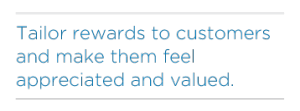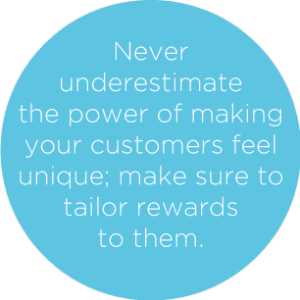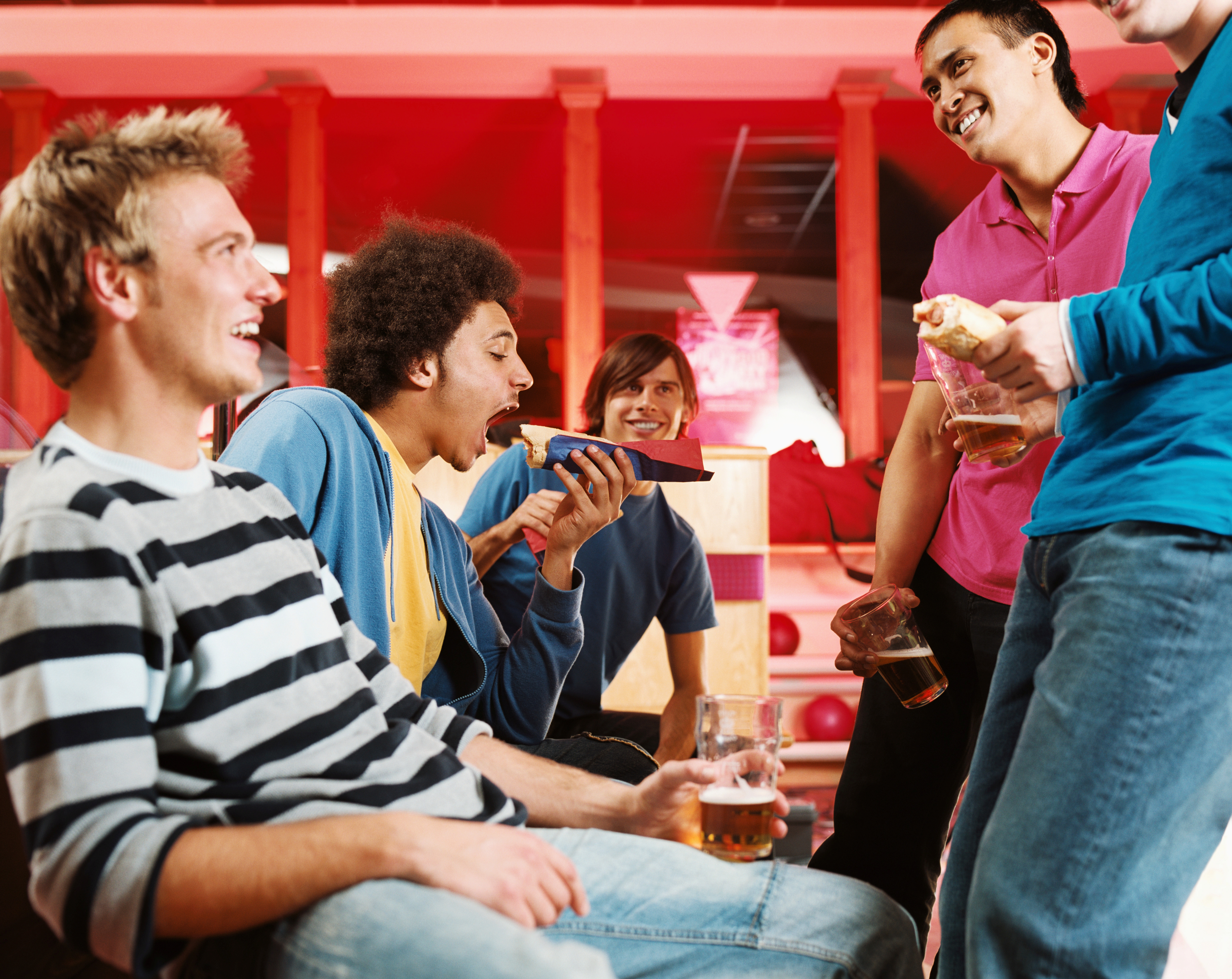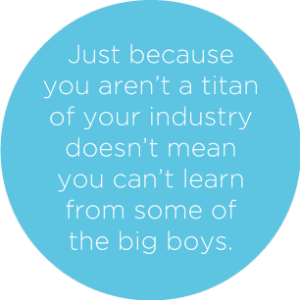You and your small business may have a way to go before you’re conducting interviews with national TV and print outlets. You probably aren’t hopping on your own private jet to check in on your various franchises across the nation or globe. And you probably are less worried about where your next seven-figure ad buy is going to appear and more worried about how to stay financially solvent for the next few years or even months.
Just because you aren’t a titan of your industry, however, doesn’t mean you can’t learn from what some of the big boys on the block are doing, especially when it comes to customer loyalty marketing. Larger companies know that customer loyalty marketing is a highly effective way to get customers to return to your business. If you’re a fan of this blog you’ll no doubt have heard us explain why it’s so crucial.
What small business owners can learn from the runaway success their bigger counterparts run
But for many small business owners, it can be somewhat daunting to get your own program off the ground. Many look to larger, Fortune 500 companies for examples and thoughts on where to begin, but many of the tactics and strategies they employ are not relevant for a much smaller company.
Taking away some core, fundamental principles is a much more applicable and manageable goal, and it can help you not only get started but get creative and unique with your own program. Let’s look at a couple and see what lessons we can glean.
MyPanera Customer Loyalty Program
Panera Bread, the popular chain of bakery/café restaurants with nearly 1,700 locations across the U.S. and Canada, has seen great success with their loyalty rewards program, MyPanera. The basics are fairly straightforward and will likely be very familiar with most consumers – enrolled members receive a card that is swiped with each purchase, and will receive rewards such as free items or discounts, recipes, etc.
While the restaurant chain is a relative newcomer to the quick-casual restaurant scene, opening up in 1981, MyPanera is even fresher (pardon the bread pun), having only been in nationwide operation since November of 2010 (it was tested at a smaller number of locations for 18 months before the full unveiling).
Customers enjoy surprises from rewards programs
The particulars of the reward program aren’t exactly eye-opening, but the success of MyPanera is. According to a recent interview with CNBC, a whopping 40-45% of all Panera Bread transactions are run through MyPanera cards, and membership is just under 10 million members. How did they do it in such a short timeframe?
One big reason is the element of surprise. A majority of rewards programs will clearly spell out what your rewards are and how you can reach them (e.g. – Buy four sandwiches and get the fifth one free). With MyPanera, customers will not necessarily know when they are eligible for a reward or what the reward even is until they swipe their card and are informed by the cashier.
According to their website, “You may get things like complimentary bakery-cafe items, exclusive previews and tastings or cooking and baking tips. Or we may surprise you with invitations to special events, ideas for entertaining, recipe books – and more! … Our Associates will inform you when you place your order if you have a reward loaded onto your card. Or you can check My Rewards before you visit and easily see what’s waiting for you.”
 Cater your rewards to your customers’ unique tastes, make them feel appreciated
Cater your rewards to your customers’ unique tastes, make them feel appreciated
Not only does this pique the curiosity of consumers, it allows Panera Bread to offer specific, tailored rewards to a specific group of customers. If your purchasing habits at Panera indicate that you’ve got more of a sweet tooth and purchase cakes and pastries far more often than their savory fare, you’re much more likely to receive a free pastry or cake recipe than would someone who normally comes in for lunch to order a traditional sandwich, and vice versa.
While it may seem like a minor addition, never underestimate the power of making your customers feel unique. By offering up rewards that are suited to a customer’s specific patterns and likes/dislikes, they are much more likely to feel as if they are a valued part of your business. And when other customers hear of the different rewards people are getting, they may very well feel intrigued to find out how they themselves could receive that reward.
Offering a surprise to the customers can remove the feeling that they are just slogging through purchases to reach a mundane reward – a term known as “grinding” within the gaming community. Keeping the amount, the frequency, and the type of reward changeable is a key takeaway from MyPanera’s success.
Red Robin Royalty Customer Rewards Program
Red Robin has approximately 450 locations throughout the U.S. and specializes in gourmet-yet-casual burgers. In January of 2010, they rolled out their Red Robin Royalty program, which offers up a variety of ways for customers to earn kickbacks while kicking back and enjoying a bite to eat.
While the Royalty program was part of a comprehensive project to improve margins and reduce expenses, it has seen enough success to become a major component of Red Robin’s marketing. “We’re hoping to drive sales primarily through traffic gains,” said then Chief Marketing Officer Susan Lintonsmith in an interview with National Restaurant Review, “Then we’ll have product news from appetizers, desserts and beverages to drive the incremental guest check, but first and foremost, it’s about traffic.”
Rewards programs can be used to increase foot traffic
Red Robin Royalty is similar to Red Robin’s menu in a way – while the restaurant focuses on excelling at a few food items, their loyalty reward program focuses on a few key reward tiers that consumers can earn. 1) Members are eligible for a free hamburger during the month of their birthday. 2) If you visit (and purchase a full meal) five times in your first five weeks in the program, you will earn $20 toward your sixth visit. 3) Every 10th menu item purchased (excluding alcohol) is free. 4) There will periodically be surprise rewards given out (but not at the frequency of Panera Bread).
By taking a more straightforward, traditional approach but mixing a small component of surprise elements in, Red Robin has taken the best of both worlds. Customers know and can expect the above standard rewards, while at the same time being kept on their toes for the random “surprise” reward occasionally sprinkled in (in the form of “special offers and great deals” per their website).
As a small business, you can create similar, creative customer experiences that Fortune 500 rewards programs offer
 So what are the main things that you, a small business owner looking to increase customer loyalty, can learn from just these two examples? One, and perhaps the most obvious, is to get creative with your rewards and think long and hard about adding surprise, unscheduled prizes into the mix.
So what are the main things that you, a small business owner looking to increase customer loyalty, can learn from just these two examples? One, and perhaps the most obvious, is to get creative with your rewards and think long and hard about adding surprise, unscheduled prizes into the mix.
It has been a proven success for Panera Bread, Red Robin, and others – although loyalty memberships have increased over the past couple of years, the participation in them is decreasing. Jeff Berry, research director for Colloquy, believes that reward program similarities and stagnation of rewards are a big reason for the lack of involvement. “Most programs seem to be all about the same kind of rewards,” he said.
 Tailor your rewards to specific groups of customers
Tailor your rewards to specific groups of customers
Also, tailor rewards to specific types of customers. This doesn’t have to be as surgical as looking at every customer’s individual habits and creating a personalized reward structure for him or her, but segmenting your customers into smaller groups based on purchase history is hugely beneficial. Not only will this help you track buying patterns to determine which of your goods are most popular and why, it will help you tailor rewards to those groups and make them feel appreciated and valued.
And finally, don’t forget the core concepts of loyalty marketing that the big and small fish alike must abide by. Stay in touch frequently. Experiment with different rewards. Don’t be afraid to be generous. Offer timed exclusives and seasonal promotions. Provide variety in the way in which your customers can earn points or the equivalent thereof.
Small business, big marketing
By staying on top of your customer data, personalizing rewards, peppering in surprise offers and discounts periodically, and getting creative with your rewards, you’ll be much more likely to turn your small business into a big one by having a strong contingent of loyal, repeat consumers.







Leave a Comment